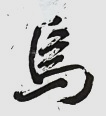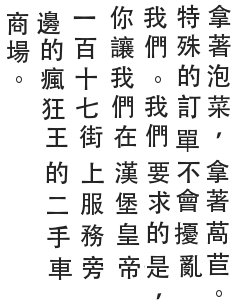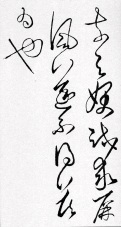
|
book reviews
Chinese calligraphy booksreviewed by T. Nelson |

|
book reviews
Chinese calligraphy booksreviewed by T. Nelson |

by Ouyang Zhongshi and Wen C. Fong
Yale, 2008, 511 pages
reviewed by T. Nelson
 he ancient Chinese are unique among the world's civilizations in having
managed to turn bad handwriting into an art form. That these paintings are
so beautiful and evocative is a testament to the power of pictograms to convey
multiple shades of meaning graphically as well as lexically.
he ancient Chinese are unique among the world's civilizations in having
managed to turn bad handwriting into an art form. That these paintings are
so beautiful and evocative is a testament to the power of pictograms to convey
multiple shades of meaning graphically as well as lexically.
The characters are often painted in such a way as to express the writer's personality; other times they are deliberately drawn to emphasize similarity to another character, as a subtle allusion that extends and deepens their meaning. Yet most Westerners are unaware of the meaning, considering them to be exotic abstractions. What we really need is a way to understand the linguistic meanings of these artistic masterpieces.
For example, last week somebody in our office put up a print of that famous Tang Dynasty Chinese poem that starts out “Moonlight falls, the crows cry.” But of course it was in calligraphy, so when I tried to read it it came out more like this:
Moonlight falls,
The horses tweet.
Frost fills the sky,
Argumentation blows.
Something something something.
Something something something.
Something something something.
The guest boat something.
Something something something.
Something something something.
Fish.

Well, I think we can all agree that this is indeed a beautiful poem. But in my defense I don't get much practice reading Tang Dynasty poetry these days. Even native Chinese people have trouble reading these documents. (Chinese is even trickier when spoken: Gong xi bai cai! = congratulations, cabbage!)
The person who bought it had absolutely no idea what it said and just thought it was nice. But it could just as easily have said this:
Hold the pickles.
Hold the lettuce.
Special orders do not upset us.
All we ask is that you let us
Serve it your way at Burger King,
One Hundred Seventeenth Street
Next to Crazy Wang's Used Car Emporium.

Online computer translation: Holding kimchi. Take the lettuce. Special orders will not disrupt us. What we demand is that you let us serve it in the way of the emperor of Hamburg, One hundred seventeen street Next to the crazy king of the used car mall.
In other words, there's a major difference between calligraphy and modern abstract art or even Western representational art: calligraphic paintings have literal, symbolic meaning. That's why even though it may not be futile to treat it as a topic for art history, doing so certainly misses the point. It would be like discussing the brush strokes of the Mona Lisa without mentioning or even noticing that there is, indeed, a picture of a rather odd-looking lady on there.
And that's the problem with this huge book. It's filled with lavish beautiful photographs of important calligraphic masterpieces, almost none of which are translated into English or even transcribed into legible Chinese. I'd highly recommend this book to connoisseurs of fine art, people interested in learning the detailed history of Chinese calligraphic painting, and anyone just interested in viewing the sumptuous pictures. But for learning their literary significance, which was what I hoped this book would provide, you'll have to look elsewhere.
Here's a typical paragraph:
Opinions differ as to the artistic merits of the Stele for Lingmiao Temple. Yang Shoujing said it was too crude and constrained to be regarded as valuable. Kang Youwei, however, described the inscription on the front as “a piece of topmost quality” and the one on the back as “divine.” (He also claimed that in pursuing a deliberately archaic style, none had surpassed Kou Quanzhi.) For his part, Sha Menghai, one of today's leading scholars in calligraphy, has commented that the calligraphy is fine but the engraving is no good.
That is really interesting, but what I was hoping for was some insight into what ideas are being communicated and why. Instead we get a lot of art criticism and art history. Valuable, but way outside my field of expertise. As you probably might have guessed by now.
nov 27, 2016

by Chiang Yee
Harvard, 1973, 250 pages
reviewed by T. Nelson
 hat this book, originally published in 1938, is still in print is a testament to how
well Chiang Yee (蔣彝) introduces Chinese writing to Westerners. Chiang,
a recognized poet and calligrapher, describes in a simple way how the characters are
constructed from strokes and radicals and how they are painted, and discusses the
different calligraphic styles and the aesthetic principles using examples from various
museums. The principles even apply to typeset characters, even though as he says they
can be dead in appearance (particularly so with the sans-serif forms like in that image
shown on this page at left) compared to those painted by a master. Uses Wade-Giles
romanization; assumes no familiarity with the language.
hat this book, originally published in 1938, is still in print is a testament to how
well Chiang Yee (蔣彝) introduces Chinese writing to Westerners. Chiang,
a recognized poet and calligrapher, describes in a simple way how the characters are
constructed from strokes and radicals and how they are painted, and discusses the
different calligraphic styles and the aesthetic principles using examples from various
museums. The principles even apply to typeset characters, even though as he says they
can be dead in appearance (particularly so with the sans-serif forms like in that image
shown on this page at left) compared to those painted by a master. Uses Wade-Giles
romanization; assumes no familiarity with the language.
None of the writing in the museum figures is translated, so this book won't help much with reading anything. The book also has several plates of Chinese paintings. In this paperback edition they are poorly reproduced; if those are of interest I'd look for an earlier hardcover edition.

The example of Grass-style calligraphy at right by Wang Xizhi from the book sacrifices legibility for beauty—the polar opposite of the example shown at left from an online translator.
dec 11, 2016

by Fang-Yü Wang
Yale, 1958, 250 pages
reviewed by T. Nelson
 fter all this work, I suddenly remembered I already had this book. There's no
plot; it's just 20 lessons covering 300 characters 15 at a time, followed by a bunch of
practice sentences written in cursive, and then some general rules about how radicals
are usually handwritten. This books assumes you can read the regular characters;
there's only a little English text here. Uses Yale romanization. This book might
not help anybody to read the kuangcao or ‘crazy grass’ style script,
and that's a shame, because the famous drunk calligrapher Huaisu (懷素)
wrote his autobiography in crazy grass style. That might be why the encyclopedias
all say things like this:
fter all this work, I suddenly remembered I already had this book. There's no
plot; it's just 20 lessons covering 300 characters 15 at a time, followed by a bunch of
practice sentences written in cursive, and then some general rules about how radicals
are usually handwritten. This books assumes you can read the regular characters;
there's only a little English text here. Uses Yale romanization. This book might
not help anybody to read the kuangcao or ‘crazy grass’ style script,
and that's a shame, because the famous drunk calligrapher Huaisu (懷素)
wrote his autobiography in crazy grass style. That might be why the encyclopedias
all say things like this:
Not much is known about his early life.
Well, there's a very good reason for that. But the general principles you get from these 300 characters make it easier to read the rest.
dec 17, 2016